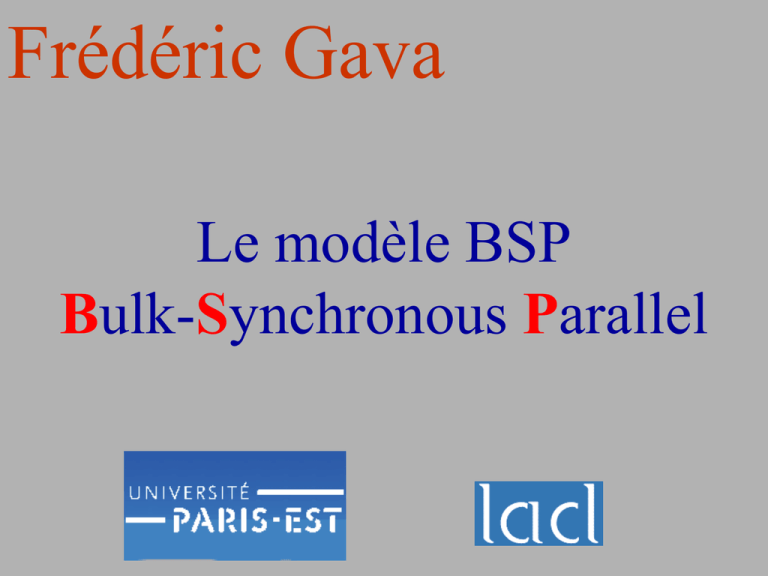Document
advertisement

Frédéric Gava Le modèle BSP Bulk-Synchronous Parallel Background Parallel programming Implicit Explicit BSP Automatic parallelization skeletons Data-parallelism Parallel extensions Concurrent programming The BSP model BSP architecture: P/M P/M Unit of synchronization P/M P/M P/M Network Characterized by: p r L g Number of processors Processors speed Global synchronization Phase of communication (1 word at most sent of received by each processor) Model of execution Global (collective) communications between processors Global synchronization : exchanged data available for the next super-step Cost(i) = (max0x<p wxi) + hig + L Super-step i+1 Local computing on each processor Super-step i Beginning of the super-step i wi ghi L wi+1 ghi+1 L Exemple d’une machine BSP 5/28 Modèle de coût • Coût(programme)=somme des coûts des super-étapes • BSP computation: scalable, portable, predictable • BSP algorithm design: minimising W (temps de calculs), H (communications), S (nombre de super-étapes) • Coût(programme) = W + g*H+ S*L • g et L sont calculables (benchmark) d’où possibilité de prédiction • Main principles: – Load-balancing minimises W – data locality minimises H – coarse granularity minimises S • In genral, data locality good, network locality bad! • Typically, problem size n>>>p (slackness) • Input/output distribution even, but otherwise arbitrary 6/28 A libertarian model No master : Homogeneous power of the nodes Global (collective) decision procedure instead No god : Confluence (no divine intervention) Cost predictable Scalable performances Practiced but confined • Advantages and drawbacks Advantages : – Allows cost prediction and deadlock free – Structuring execution and thus bulk-sending ; it can be very efficient (sending one file of 1000 bytes performs better than sending 1000 file of 1 byte) in many architectures (multi-cores, clusters, etc.) – Abstract architecture = portable – …? • Drawbacks : – Some algorithmic patterns don’t feet well in the BSP model : pipeline etc. – Some problem are difficult (impossible) to feet to a Coarse-grain execution model (fine-grained parallelism) – Abstract architecture = don’t take care of some efficient possibilities of some architecture (cluster of multi-core, grid) and thus need other libraries or model of execution – …? Example : broadcast Direct broadcast (one super-step): 0 1 BSP cost = png + L Broadcast with 2 super-steps: BSP cost = 2ng + 2L 2 Algorithmes BSP • Matrices : multiplication, inversion, décomposition, algèbre linéaire, etc. • Matrices creuses : idem. • Graphes : plus court chemin, décomposition, etc. • Géométrie : diagramme de Voronoi, intersection de polygones, etc. • FFT : Fast Fournier Transformation • Recherches de motifs • Etc. 10/28 Parallel prefixes If we suppose associative operator (+) a+(b+c)=(a+b)+c or better a+(b+(c+d))=(a+b) + (c+d) Example : On a processor On another processor Parallel Prefixes Classical log(p) super-steps method : 0 1 2 Cost = log(p) × ( Time(op)+Size(d)×g+L) 3 Parallel Prefixes Divide-and-conquer method : 0 1 2 3 Our parallel machine • Cluster of PCs – Pentium IV 2.8 Ghz – 512 Mb RAM • A front-end Pentium IV 2.8 Ghz, 512 Mb RAM • Gigabit Ethernet cards and switch, • Ubuntu 7.04 as OS Our BSP Parameters ‘g’ Our BSP Parameters ‘L’ How to read bench • There are many manners to publish benchs : – – • • Tables Graphics The goal is to say « it is a good parallel method, see my benchs » but it is often easy to arrange the presentation of the graphics to hide the problems Using graphics (from the simple to hide to the hardest) : 1) 2) 3) 4) 5) Increase size of data and see for some number of processors Increase number of processors to a typical size of data Acceleration, i.e, Time(seq)/Time(par) Efficienty , i.e, Acceleration/Number of processors Increase number of processors and size of the data Increase number of processors Acceleration Efficienty Increase data and processors Super-linear acceleration ? • Better than theoretical acceleration. Possible if data feet more on caches memories than in the RAM due to a small number of data on each processor. • Why the impact of caches ? Mainly, each processor has a little of memory call cache. Access to this memory is (all most) twice faster that RAM accesses. • Take for example, multiplication of matrices “Fast” multiplication • A straight-forward C implementation of res=mult(A,B) (of size N*N) can look like this : for (i = 0; i < N; ++i) for (j = 0; j < N; ++j) for (k = 0; k < N; ++k) res[i][j] += a[i][k] * b[k][j]; • Considerer the following equation : where “T” is the transposition of matrix “b” “Fast” multiplication • One can implement this equation in C as : double tmp[N][N]; for (i = 0; i < N; ++i) for (j = 0; j < N; ++j) tmp[i][j] = b[j][i]; for (i = 0; i < N; ++i) for (j = 0; j < N; ++j) for (k = 0; k < N; ++k) res[i][j] += a[i][k] * tmp[j][k]; where tmp is the transpose of “b” • This new multiplication if 2 time fasters. With other caches optimisations, one can have a 64 faster programs without modifying really the algorithm. More complicated examples N-body problem Presentation • We have a set of body – coordinate in 2D or 3D – point masse • The classic N-body problem is to calculate the gravitational energy of N point masses that is : • Quadratique complexity… • In practice, N is very big and sometime, it is impossible to keep the set in the main memory Parallel methods • • Each processor has a sub-part of the original set Parallel method one each processsor : 1) compute local interactions 2) compute interactions with other point masses 3) parallel prefixes of the local interactions • For 2) simple parallel methods : – using a total exchange of the sub-sets – using a systolic loop Cost of the systolic method : Systolic loop 0 1 2 3 Benchs and BSP predictions Benchs and BSP predictions Benchs and BSP predictions Parallel methods • • • • There exist many better algorithms than this one Especially, considering when computing all interactions is not needed (distancing molecules) One classic algorithm is to divide the space intosubspace, and computed recursively the n-body on each sub-space (so have sub-sub-spaces) and only consider, interactions between these sub-spaces. Stop the recursion when there are at most two molecules in the sub-space That introduces n*log(n) computations Sieve of Eratosthenes Presentation • Classic : find the prime number by enumeration • Pure functional implementation using list • Complexity : n×log(n)/log(log(n)) • We used : – elim:int listintint list which deletes from a list all the integers multiple of the given parameter – final elim:int listint listint list iterates elim – seq_generate:intintint list which returns the list of integers between 2 bounds – select:intint listint list which gives the first prime numbers of a list. Parallel methods • Simple Parallel methods : – using a kind of scan – using a direct sieve – using a recursive one • Different partitions of data – per block (for scan) : 11,12,13,14,15 16,17,18,19,20 21,22,23,24,25 12,15,18,21,24 13,16,19,22,25 – cyclic distribution : 11,14,17,20,23 Scan version • Method using a scan : – Each processor computes a local sieve (the processor 0 contains thus the first prime numbers) – then our scan is applied and we eliminate on processor i the integers that are multiple of integers of processors i−1, i−2, etc. • Cost : as a scan (logarithmic) Direct version • Method : – each processor computes a local sieve – then integers that are less to are globally exchanged and a new sieve is applied to this list of integers (thus giving prime numbers) – each processor eliminates, in its own list, integers that are multiples of this first primes Inductive version • Recursive method by induction over n : – We suppose that the inductive step gives the th first primes – we perform a total exchange on them to eliminates the non-primes. – End of this induction comes from the BSP cost: we end when n is small enough so that the sequential methods is faster than the parallel one • Cost : Benchs and BSP predictions Benchs and BSP predictions Benchs and BSP predictions Benchs and BSP predictions Parallel sample sorting Presentation • Each processor has listed set of data (array, list, etc.) • The goal is that : – data on each processor are ordored. – data on processor i are smaller than data on processor i+1 – good balancing • Parallel sorting is not very efficient due to too many communications • But usefull and more efficient than gather all the data in one processor and then sort them Tri Parallèle BSP 46/28 Tiskin’s Sampling Sort 0 1,11,16,7,14,2,20 1 2 18,9,13,21,6,12,4 15,5,19,3,17,8,10 4,6,9,12,13,18,21 3,5,8,10,15,17,19 Local sort 1,2,7,11,14,16,20 Select first samples (p+1 elements with at last first and last ones) 1,2,7,11,14,16,20 4,6,9,12,13,18,21 3,5,8,10,15,17,19 Total exchange of first sample 1,7,14,20,4,9,13,21,3,8,15,19 1,7,14,20,4,9,13,21,3,8,15,19 1,7,14,etc. Local sort of samples (each processor) 1,3,4,7,8,9,13,14,15,19,20,21 1,3,4,7,8,9,13,14,15,19,20,21 1,3,4,7,etc. Tiskin’s Sampling Sort Select second samples (p+1 elements with at last first and last ones) 1,3,4,7,8,9,13,14,15,19,20,21 1,3,4,7,8,9,13,14,15,19,20,21 1,3,4,7,etc. Interval for processor 0 Interval for processor 1 Interval for processor 2 1,2,7,11,14,16,20 4,6,9,12,13,18,21 3,5,8,10,15,17,19 1,2,7 4,6 3,5 11,14 9,12,13 8,10 16,20 18,21 15,17,19 Fusion of receveid and sorted elements 1,2,3,4,5,6,7 8,9,10,11,12,13,14 15,16,17,18,19,20,21 Benchs and BSP predictions Benchs and BSP predictions Matrix multiplication Naive parallel algorithm • • • • • We have two matrices A and B of size n×n We supose Each matrice is distributed by blocs of size That is, element A(i,j) is on processor Algorithm : Each processor reads twice one bloc from another processor Benchs and BSP predictions Benchs and BSP predictions Benchs and BSP predictions Benchs and BSP predictions Data-Parallel Skeletons Algorithm Skeletons • Skeletons encapsulate basic parallel programming patterns in a well understood and structured approach • Thus, skeletons are a set of functions which have 2 semantics : sequential and parallel ones. • In general, skeletons work one list of data : a stream in the parallel semantics • Typical examples : pipeline, farm, etc. • Data-parallel skeletons are design for work on data and not one the stream of data • Data-parallel skeletons has been design for lists, trees, etc. Our Skeletons • Work on lists : each processor has a sub-list • Map : application of a function on list of data : • Zip : combines elements of two lists of equal length with a binary operation : • Reduce and scan • Rpl : creates a new list containing n times element x Distributable Homomorphism • Dh : know as butterfly skeleton and used to express a special class of divide-and-conquer algorithms • Récursive définition : • where : • and Distributable Homomorphism • The butterfly (if x and y lists of data) : • Which is also a parallel point of view… Example dh dh + × [1;2;3;4;5;6;7;8] [1;2;3;4;5;6;7;8] [1;2;3;4] [1;2] [10+26;14+86;21+165;24+1680; 10*26;14*86;21*165;24*1680] = [36;100;186;1704;260;1204;3465;40320] [3+7;2+12;3*7;2*12] = [10;14;21;24] [1+2;1*2] [3;4] = [3;2] [5;6;7;8] [3+4;3*4] [5;6] = [7;12] [11+15;30+56;11*15;30*56] = [26;86;165;1680] [5+6;5*6] [7;8] = [11;30] [7+8;7*8] = [15;56] Parallel Implementation • Currently, naive implementation : suppose 2^l processors (even, you need to manage bording data) • Recursive implementation using superposition • BSP Cost = logarithmic number of super-step with at most 2^(l-p) data communicated • Application : Fast Fourier Transformation (FFT) and Tridiagonal System Solver (TDS) Fast Fourier Transformation Presentation • Usefull in many numeric applications • Définition (n=2^l) : Skeleton implementation • Recursive computation : • where • Operator : • Skeleton code : • where : and Benchs and BSP predictions Benchs and BSP predictions Benchs and BSP predictions Benchs and BSP predictions Benchs and BSP predictions Benchs and BSP predictions Tridiagonal System Solver Presentation • Usefull in many applications • A×x = b where A is sparce matrix representing coefficients, x a vector of unknowns and b a righthand-side vector. • The only values of A unequal to 0 are on the main diagonal, as well as directly above and below it • Can be implemented using dh as FFT but just other operators… Benchs and BSP predictions Benchs and BSP predictions Benchs and BSP predictions Benchs and BSP predictions Benchs and BSP predictions Benchs and BSP predictions





